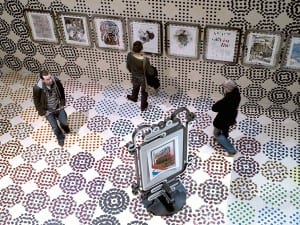Only 22% of the design workforce in the UK is female, according to a report by the British Design Council from 2015 – a figure that is less than half the national statistic. In Women Design, a new book published by Frances Lincoln and written by Libby Sellers, the endsheets are made up of an infographic that interprets this 78:22 divide, and the stark gender inequality that faces the industry.
This year marks the centenary of the efforts of women’s suffrage for the right to vote in the UK, whilst the Bauhaus also approaches its 100-year anniversary. Founded as a school in Weimar, Germany, it subsequently moved to Dessau and Berlin, before closing in 1933 under political pressure. It had a commitment to forward-thinking innovation and egalitarianism, and in its first year open, more women than men applied to study.

Yet, as Sellers is eager to make clear from the start, the Bauhaus did very little to break away from convention; a student’s suitability for a particular discipline was dependent on gender, leaving female students to mainly take up weaving. The names that are often associated with the school are almost exclusively male, whilst the work of alumni Anni Albers (1899 – 1994), Marianne Brandt (1893 – 1983) and Lilly Reich (1885 – 1947) is equally as inspiring as that of their counterparts.
This thought-provoking text uses this significant year to profile 21 women whose design has had considerable influence on the wider world. The case of Ray Eames (1912-1988) is poignant, as Sellers writes, “sometimes it is all too easy to just write one name.” Though Eames was one half of a duo with her husband, Charles, that distinction and acknowledgment is rarely made. Even during her lifetime, Eames was often referred to as supportive wife and homemaker, despite having a profound impact on mid-century home design.

To avoid emphasis on hierarchy, a leading factor that has long contributed to the absence of women in history, the entries in Women Design do not follow a chronology, nor is there a focus on geography or a preference for discipline. The biographies of 20th century pioneers, like Eileen Gray (1878 – 1976), are interspersed with the modern-day trailblazers, like Kazuyo Sejima (b. 1956). Sellers pays homage to those who have been painstakingly rewriting the trajectories of art and design, in order to re-incorporate women, since the 1980s. The book offers a necessary celebration of the past, but also seeks to redress the balance going forward. In the context of the Time’s Up and #MeToo movements, there is still much work to be done, but this publication is a necessary and positive contribution.
Women Design was published by Frances Lincoln, on 7 June. Find out more.
Credits:
1. Lina Bo Bardi on the steps of the Casa de Vidro, Francisco Albuquerque, Institute Lina Bo e P. M. Bardi, Brazil, 1951.
2. Lucia Moholy,Bauhaus Building, Dessau 1925–6. Courtesy of Tate.
3. Installation view of Glimpses of the U.S.A., American National Exhibition, Moscow, 1959 An Eames Celebration Exhibition at Vitra Design Museum © Eames Office LLC.





